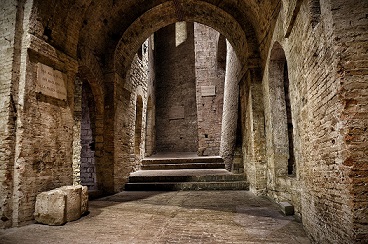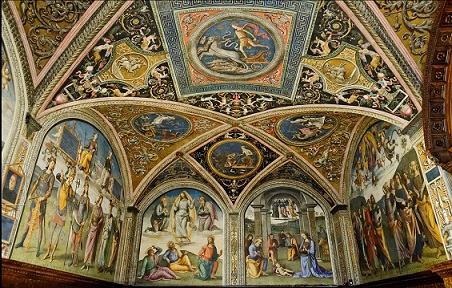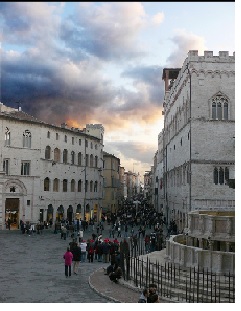About Perugia

Perugia is the capital of the Umbria Region (the Green Heart of Italy), and is located in central Italy. The town is of Etruscan originand contains more than 160,000 inhabitants.
The Acropolis of Perugia (about 490 m a.s.l.) has been selected by the Etruscan people for the topographic arrangement on two contiguous hills, Colle del Sole and Colle Landone, and for the water resources.
The oldest urban center is enclosed by walls dating from the 3rd Century BC, that are themselves incorporated into a medieval fortification (14th Century).
The latter fortification encompasses the five villages (or districts) that have developed along the five main hill ridges towards the surrounding suburbs. This expansion took place in five directions, corresponding to the five Etruscan doors and has given the city a stellar shape that Renaissance architect Leon Battista Alberti compared to the fingers of a hand.

Its rich history is well represented by the works of art housed in the most representative cities, and the numerous monuments that characterize the urban profile of its historic center. Among these monuments is first and foremost the Fontana Maggiore, built in the 13th Century. After construction of the aqueduct through which water was channeled to the center of the city, and which is still accessible today. In the Piazza IV November there is the Cathedral of San Lorenzo, which was completed during the 15th Century. The Palazzo dei Priori built between the 14th and 16th Century, is now the Town Hall of the Municipality of Perugia, and contains the National Gallery of Umbria, the region’s most important museum. Here visitors can admire works of artists such as Pinturicchio, Perugino, Pietro della Francesca, Gentile da Fabriano, and other work of arts covering a time span between the 13th and 19th Century.

Among the many other architectural works worthy of mention is Rocca Paolina, a fortress built by Pope Paul III in 1540, at the end of the Salt War, in which Perugia fought against the Papal State imposing taxes on the importation of marine salt. Only one wing remains of this monumental building, designed by Sangallo the Younger, one of the greatest military engineers of the 16th Century. The area under the building, the major underground citadel, is still accessible, however, having become one of the symbols of the city. It is now crossed by a path of escalators leading from the main bus terminal up to the city center.
Perugia is the home of one of the oldest universities in Italy, founded in 1308, as attested by the Papal Bull issued by Pope Clement V certifying the birth of the Studium Generale. In addition to the University of Perugia is the University for Foreigners, founded in 1925, being the oldest university in Italy addressed to foreigners, and which specializes in the teaching and diffusion of the Italian language and culture worldwide.
In this highly suggestive scenario, and rich history, art and science surroundings, many cultural activities take place, making Perugia one of the most dynamic and attractive Italian cities. The best globally-known initiatives range from international music festivals (Umbria Jazz) to promotion of economic activities and crafts (UmbriaLibri), and from local confectionery production (Eurochocolate) to large conferences in the field of media and information (International Journalism Festival), and science (Perugia Science Fest or The Isle of Einstein).
Tourist guides
- Perugia and its districts
- Perugia Itinerary 1 and 2
- Perugia Itinerary 3 and 4
- Perugia Itinerary 5 and 6
- Perugia culture and lifestyle
Reaching Perugia
Here you can find some information about how to reach Perugia and contacts of the major Italian transportation companies.
By Bus (from Rome-Fiumicino Airport to Perugia)
If you take the Sulga bus (www.sulga.it) from Rome-Fiumicino Airport, you will arrive at Piazza Partigiani, the bus station in the Perugia city center.
The bus station at the airport is located in the parking area in front of Terminal 3, arrivals level. To find the bus station (Sulga bus) to Perugia please go outside the arrival gate and walk to your right until the end of terminals, following the “Bus Station” sign. You should see a series of bus parking spaces. The Sulga buses to Perugia arrive at the bus stops 35 or 36
There is no timetable for the Sulga busses available at the Rome-Fiumicino Airport. Please check the latest timetable in advance:
The one-way bus fare from Rome-Fiumicino Airport to Perugia or vice versa is about € 22, and the roundtrip fare is about € 36 (valid for one month). The tickets can be purchased on board and by cash only or in advance on the Sulga website.
By train
Plese check the official website of TRENITALIA (National railways)
Telephone +39 075 5006186 www.trenitalia.com
By plane
San Francesco d’Assisi - Umbria International Airport - Perugia 12 km from Perugia Telephone +39 075 592141 www.airport.umbria.it
Amerigo Vespucci Airport - Florence 160 km from Perugia - 235 km from Terni Telephone +39 055 3061300 www.aeroporto.firenze.it
Leonardo da Vinci International Airport - Rome 210 km from Perugia - 120 km from Terni Telephone +39 06 65951 www.adr.it
Galileo Galilei Airport - Pisa 230 km from Perugia - 300 km from Terni Tel. +39 050 849300 www.pisa-airport.com
By car
A1 Motorway Florence-Rome Exits: Valdichiana (follow traffic signs for Terontola-Perugia junction), Chiusi-Chianciano, Orte(follow traffic signs for Perugia-Cesena), Attigliano, Orvieto, Fabro www.autostrade.it/en/index.html
A14 Motorway Bologna-Bari Arriving from the North, exits at Rimini (follow traffic signs for Città di Castello), Fano (follow traffic signs for Gubbio) Arriving from the South, exits at Ancona Nord (follow traffic signs for Gubbio), Pescara (follow traffic signs for Terni via L’Aquila-Rieti), Civitanova Marche (follow traffic signs for Foligno-Perugia) www.autostrade.it/en/index.html
Dual carriage-way E45 Cesena-Orte Crosses Umbria from top to bottom
COVID 19
We planned the 2021 edition of the conference to be a mixed in-person and online event.
We are working to understand if this is still allowed by the pandemic situation. The rule to participate in indoor activities in Italy, effective August 6th, is that a “green pass” (electronic certificate of full vaccination) is mandatory. Indoor activities include restaurants, cinemas, concerts and conferences. It looks like, effective September 1st, a “green pass” will also be necessary to travel by plane or train, but this is still under debate.
Please check this page for updates about the possibility of in-person attendance and upcoming regulations on this page. And please check with your country’s travelling regulations before making plans to travel to Italy.
